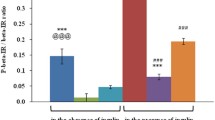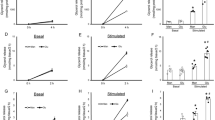Summary
It has been suggested that bradykinin stimulates glucose uptake in experiments in vivo and in cultured cells. However, its mechanism has not yet been fully elucidated. In this study, the effects of bradykinin on the insulin signalling pathway were evaluated in isolated dog adipocytes. The bradykinin receptor binding study revealed that dog adipocytes possessed significant numbers of bradykinin receptors (Kd=83 pmol/l, binding sites = 1.7×104 site/cell). Reverse transcription-polymerase chain reaction amplification showed the mRNA specific for bradykinin B2 receptor in the adipocytes. Bradykinin alone did not increase 2-deoxyglucose uptake in adipocytes; however, in the presence of insulin (10−7 mol/l) it significantly increased 2-deoxyglucose uptake in a dose-dependent manner. Bradykinin also enhanced insulin stimulated GLUT4 translocation from the intracellular fraction to the cell membrane, and insulin induced phosphorylation of the insulin receptor Β subunit and insulin receptor substrate-1 (IRS-1) without affecting the binding affinities or numbers of cell surface insulin receptors in dog adipocytes. The time-course of insulin stimulated phosphorylation of the insulin receptor Β subunit revealed that phosphorylation reached significantly higher levels at 10 min, and stayed at the higher levels until 120 min in the presence of bradykinin, suggesting that bradykinin delayed the dephosphorylation of the insulin receptor. It is concluded that bradykinin could potentiate insulin induced glucose uptake through GLUT4 translocation. This effect could be explained by the potency of bradykinin to upregulate the insulin receptor tyrosine kinase activity which stimulates phosphorylation of IRS-1, followed by GLUT4 translocation.
Similar content being viewed by others

Abbreviations
- NIDDM:
-
non-insulin-dependent diabetes mellitus
- IRS-1:
-
insulin receptor substrate-1
- PI3′-kinase:
-
phosphatidylinositol 3′-kinase
- GLUT4:
-
glucose transporter type 4
- HEPES:
-
N-(2-hydroxyethyl)-piperazine-N′-2-ethane sulphonic acid
- PMSF:
-
phenylmethyl sulphonyl fluoride
- BSA:
-
bovine serum albumin
- PBS:
-
phosphate buffered saline
- HBSS:
-
Hanks' balanced salt solution
- LDM:
-
low density microsome
- RT-PCR:
-
reverse transcriptase-polymerase chain reaction
- PL(C, A):
-
phospholipase (C, A)
References
Bhoola KD, Figueroa CD, Worthy K (1992) Bioregulation of kinins: kallikreins, kininogens, and kininase. Pharmacol Rev 44: 1–80
Uehara M, Kishikawa H, Isami S et al. (1994) Effect on insulin sensitivity of angiotensin converting enzyme inhibitors with or without a sulphydyl group: bradykinin may improve insulin resistance in dogs and humans. Diabetologia 37: 300–307
Wicklmayr M, Dietze G, Günther B, Boettger I, Mayer L, Janetschek P (1979) Improvement in glucose assimilation and protein degradation by bradykinin in maturity onset diabetics and in surgical patients. Kinins II:569–576
Goldman J, Pfister D, Vukmirovich R (1987) Potentiation of insulin stimulation of hexose transport by kallikrein and bradykinin in isolated rat adipocytes. Mol Cell Endocrinol 50: 183–191
Dettori C, Meldolesi J (1989) Regulation of glucose transport by insulin, bombesin, and bradykinin in Swiss 3T3 fibroblast: involvement of protein kinase C-dependent and -independent mechanisms. Exp Cell Res 182: 267–278
Dietze G, Wicklmayr M, Mayer L, Bottger I, Funcke HV (1978) Bradykinin and human forearm metabolism: inhibition of endogenous prostaglandin synthesis. Hoppe-Seylers Z Physiol Chem 359: 369–378
Shimojo N, Pickens TG, Margolius HS, Mayfield RK (1987) Tissue kallikrein and bradykinin do not have direct insulin-like actions on skeletal muscle glucose utilization. Biol Chem Hoppe Seyler 368: 1355–1361
Hall JM (1992) Bradykinin receptors: pharmacological properties and biological roles. Pharmacol Ther 56: 131–190
Trifilieff A, Haddad EB, Landry Y, Gies JP (1991) Evidence for two high-affinity bradykinin binding sites in the guinea-pig lung. Eur J Pharmacol 207: 129–134
Kahn CR (1994) Insulin action, diabetogenes, and the cause of type II diabetes. Diabetes 43: 1066–1084
Berlan MC, Carpene C, Lafontan M, Dang TL (1982) Alpha2-adrenergic antilipolitic effect in dog fat cells: incidence of obesity and adipose tissue localization. Horm Metab Res 14: 257–260
Roscher AA, Manganiello VC, Jelsema CL, Moss J (1983) Receptor for bradykinin in intact cultured human fibroblasts. Identification and characterization by direct binding study. J Clin Invest 72: 626–635
Scatchard G (1949) The attractions of proteins for small molecules and ions. Ann NY Acad Sci 51: 660–672
Chirgwin JM, Przybyla AE, MacDonald RJ, Rutter WJ (1979) Isolation of biologically active ribonucleic acid from sources enriched in ribonuclease. Biochemistry 18: 5294–5299
Saiki RK, Gelfand DH, Stoffel S et al. (1988) Primer-directed enzymatic amplification of DNA with a thermostable DNA polymerase. Science 239: 487–489
McIntyre P, Phillips E, Skidmore E, Brown M, Webb M (1993) Cloned murine bradykinin receptor exhibits a mixed B1 and B2 pharmacological selectivity. Mol Pharmacol 44: 346–355
Hess JF, Borkowski JA, Young GS, Strader CD, Ransom RW (1992) Cloning and pharmacological characterization of a human bradykinin (BK-2) receptor. Biochem Biophys Res Commun 184: 260–268
Olefsky JM (1978) Mechanism of the ability of insulin to activate the glucose transport system in rat adipocytes. Biochem J 172: 137–145
Campbell DJ, Kladis A, Ducan AM (1993) Bradykinin peptides in kidney, blood, and other tissues of the rat. Hypertension 21: 155–165
Simpson IA, Yver DR, Hissin PJ et al. (1983) Insulin-stimulated translocation of glucose transporters in the isolated rat adipose cells: characterization of subcellular fraction. Biochim Biophys Acta 763: 3939–3947
Kobayashi M, Iwasaki M, Shigeta Y (1980) Receptor mediated insulin degradation decrease by chloroquine in isolated rat adipocytes. J Biochem 88: 39–44
Hotamisligil GS, Budavari A, Murray D, Spiegelman BM (1994) Reduced tyrosine kinase activity of the insulin receptor in obesity-diabetes. J Clin Invest 94: 1543–1549
Menke JG, Borkowski JA, Bierilo K et al. (1994) Expression cloning of a human B1 bradykinin receptor. J Biol Chem 269: 21583–21586
Manning DC, Vavrek R, Stewart JM, Snyder SH (1986) Two bradykinin binding sites with picomolar affinities. J Pharmac Exp 237: 504–512
Ranson RW, Young GS, Schneck K, Goodman CB (1992) Characterization of solubilized B2 receptor from smooth muscle and mucosa of guinea-pig ileum. Biochem Pharmac 43: 1823–1827
Sharif NA, Whiting RL (1991) Identification of B2 -bradykinin receptors in guinea-pig brain regions, spinal cord and peripheral tissues. Neurochem Int 18: 89–96
Denning GM, Welsh MJ (1991) Polarized distribution of bradykinin receptors on airway epithelial cells and independent coupling to second messenger pathways. J Biol Chem 266: 12932–12938
Wolsing DH, Rosenbaum JS (1991) Bradykinin-stimulated inositol phosphate production in NG108-15 cells is mediated by a small population of binding sites which rapidly desensitize. J Pharmacol Exp Ther 257: 621–633
Cahill M, Fishman JB, Polger P (1988) Effect of des arginine9-bradykinin and other bradykinin fragments on the synthesis of prostacyclin and the binding of bradykinin by vascular cells in culture. Agents Actions 24: 224–231
Proud D, Reynolds CJ, Broomfield J, Goldman DW, Bathon JM (1993) Bradykinin effects in guinea pig tracheal cells are mediated through a B2 kinin receptor and can be inhibited by the selective antagonist Hoe 140. J Pharmacol Exp Ther 264: 1124–1131
Kanai F, Ito K, Todaka M et al. (1993) Insulin-stimulated GLUT4 translocation is relevant to the phosphorylation of IRS-1 and the activity of PI3-kinase. Biochem Biophys Res Commun 195: 762–768
Ebina Y, Araki E, Taira M et al. (1987) Replacement of lysine residue1030 in the putative ATP-binding region of the insulin receptor abolishes insulin- and antibody-stimulated glucose uptake and receptor kinase activity. Proc Natl Acad Sci U S A 84: 704–708
Araki E, Lipes MA, Patti ME et al. (1994) Alternative pathway of insulin signalling in mice with targeted disruption of the IRS-1 gene. Nature 372: 186–190
Tamemoto H, Kadowaki T, Tobe K et al. (1994) Insulin resistance and growth retardation in mice lacking insulin receptor substrate-1. Nature 372: 182–186
Maegawa H, Ide R, Hasegawa M et al. (1995) Thiazolidine derivatives ameliorate high glucose-induced insulin resistance via the normalization of protein-tyrosine phosphatase activities. J Biol Chem 170: 7724–7730
Gutowski S, Smrcka A, Nowak L, Wu DG, Simon M, Sternweis PC (1991) Antibodies to the alpha q subfamily of guanine nucleotide-binding regulatory protein alpha subunits attenuate activation of phosphatidylinositol 4,5-bisphosphate hydrolysis by hormones. J Biol Chem 266: 20519–20524
Wilk-Blaszczak MA, Gutowski S, Sternweis PC, Belardetti F (1994) Bradykinin modulates potassium and calcium currents in neuroblastoma hybrid cells via different pertussis toxin-insensitive pathways. Neuron 12: 109–116
Garton AJ, Tonks NK (1994) PTP-PEST: a protein tyrosine phosphatase regulated by serine phosphorylation. EMBO J 13: 3763–3771
Ljunggren O, Fredholm BB, Nordstedt C, Ljunghall S, Lerner UH (1993) Role of protein kinase C in bradykinin-induced prostaglandin formation in osteoblasts. Eur J Pharmacol 244: 111–117
HÄring HU, Kellerer M, Mosthaf L (1994) Modulation of insulin signalling in non-insulin-dependent diabetes mellitus: significance of altered receptor isoform patterns and mechanisms of glucose-induced receptor modulation. Horm Res 2: 87–91
Berti L, Mosthaf L, Kroder G et al. (1994) Glucose-induced translocation of protein kinase C isoforms in rat-1 fibroblasts is paralleled by inhibition of the insulin receptor tyrosine kinase. J Biol Chem 269: 3381–3386
Leeb LL, Song XH (1991) Bradykinin and bombesin rapidly stimulate tyrosine phosphorylation of a 120-kDa group of proteins in Swiss 3T3 cells. J Biol Chem 266: 7746–7749
Constable SH, Favier RJ, Uhl J, Holloszy JO (1986) Bradykinin does not mediate activation of glucose transport by muscle contraction. J Appl Physiol 61: 881–884
Author information
Authors and Affiliations
Rights and permissions
About this article
Cite this article
Isami, S., Kishikawa, H., Araki, E. et al. Bradykinin enhances GLUT4 translocation through the increase of insulin receptor tyrosine kinase in primary adipocytes: evidence that bradykinin stimulates the insulin signalling pathway. Diabetologia 39, 412–420 (1996). https://doi.org/10.1007/BF00400672
Received:
Revised:
Issue Date:
DOI: https://doi.org/10.1007/BF00400672



